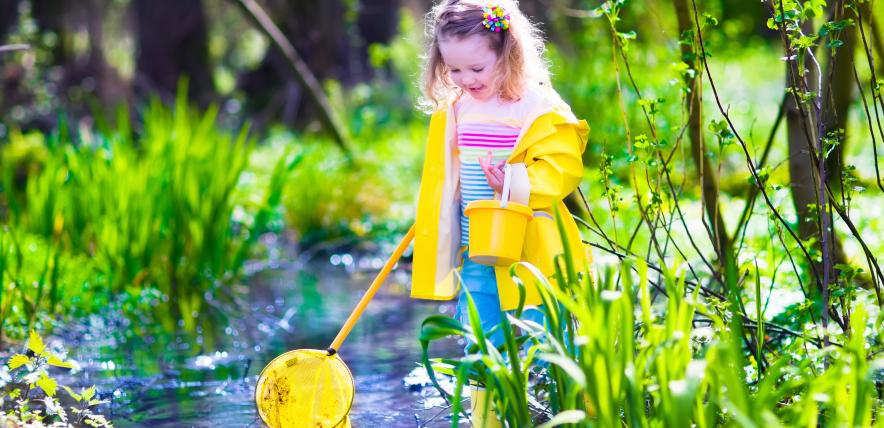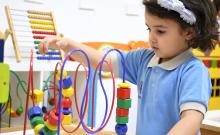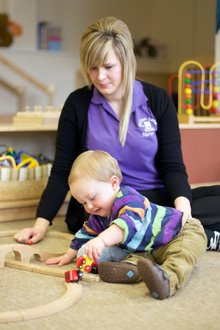Wherever you live there are lots of fun ways that you and your child can enjoy nature together. Here are a few ideas to try in the garden, park, woods, or on the beach…
Treasure trove
Young children love to collect things whenever they're out and about. Encourage them by making a 'collecting stick' – a stick with a few elastic bands wound around it. As you walk, tuck fallen leaves, feathers, seed pods, flowers, twigs – whatever takes your child's fancy – into the bands to create a pretty souvenir of your outing.
Alternatively, give your little one an egg box and encourage them to find something beautiful to put into each compartment of their 'treasure chest': perhaps a shiny pebble, hatched-out bird's egg or colourful petal.
For instant art, make a cardboard frame filled with sticky-backed plastic for your child to stick their 'treasure' on to as you walk. Or use a nappy-sack for collecting and make a collage when you get home. Draw an outline of a hedgehog to fill with spiky autumn leaves, or an owl to fill with feathers.
Keep some collected materials for days when you can't get out. Examining and sorting a collection of fircones, pebbles, shells or conkers can keep a young child absorbed for ages.
Whatever the weather
Exploring the natural world doesn't have to be a fair-weather pastime. On a wet day, don wellies and waterproofs and find puddles to splash in or mud to squelch through. Look out for worms, slugs and snails as you walk. Did you know that snails have a homing instinct? Take them up to ten metres from your home, dab a spot of nail varnish on their shell, and look out for the painted snail reappearing in your garden.
A misty autumn day is perfect for spotting spiders' webs glistening with dew, brightly coloured toadstools or strangely shaped fungi. Why not photograph them, so you can look up their names on the internet when you get home?
On a freezing day, find icy puddles to slide on or crack open, catch snowflakes on your tongue or use a magnifying glass to examine those that settle on your sleeve. In sub-zero temperatures it's important to take care of our feathered friends, so put some scraps out or find a bird cake recipe online, and watch who comes to feed.
Creature feature
Turn your little one into a nature detective, looking out for signs of wildlife such as snail trails, rabbit droppings, deer footprints, birds' nests, or cuckoo spit (from froghopper larvae). Try pond-dipping, rock-pooling or bug-hunting, using clear containers and a magnifying glass to help your child study their catches. Identify and learn about your finds using the internet, and talk about the importance of treating them gently and putting them back where you found them.
You could try making a bug hotel to hang outside your home. Pack a flowerpot or weatherproof box with some cut-up bamboo canes, fircones, dead wood, moss and corrugated cardboard, and leave in a sheltered spot to see what moves in.
Let's get physical
Children love to balance along logs, make footprints in the sand, tiptoe over stepping stones, kick piles of fallen leaves, stomp in puddles, climb trees or jump over waves. They may think they're just having fun, but these activities are great physical exercise and will help them develop the muscle control, strength and co-ordination they'll need to play sports, ride a bike, and so on when they're older.
If you have a garden, set up a 'mud kitchen' with some old pans, cups, sieves and spoons. Making mud pies, sand sundaes or grass soup involves lots of picking, mixing, stirring and pouring – all perfect for developing little hand muscles that will one day need to write and draw. The mud kitchen also develops children's problem-solving and language skills. Which is the best pan to use? How can we make the soup runnier? How does the wet mud feel? What do the petals smell like?
Senses and sensibility
When you're exploring nature with your child, encourage them to use all five of their senses. Listen for birdsong or crickets; taste some ripe blackberries; feel the prickly outside and velvety inside of a conker case; look for different colours and patterns of spots on ladybirds; smell some seaweed or wild garlic. As you do so, you'll be helping them to observe, concentrate, listen and communicate – all useful skills for school later on.
Research suggests that playing in the natural world can reduce children's stress levels and boost their immune systems. You'll probably find that they have a great appetite and sleep well after a busy day in the open air too. So what are you waiting for…?!
Written for the Early Years Alliance by Elyssa Campbell-Barr.
This blog post was edited and updated on 11 April 2023.
Where next?
How do I teach my child to ride a bike?







